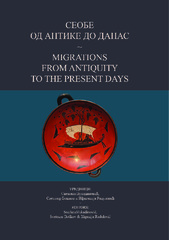Prikaz osnovnih podataka o dokumentu
Варварска елита у римској служби у периоду од средине IV до средине V века
Barbarian elite in Roman service in the period from the mid-4 th to the mid-5 th Century
| dc.contributor | Вукадиновић, Снежана | |
| dc.contributor | Бошков, Светозар | |
| dc.contributor | Радуловић, Ифигенија | |
| dc.creator | Лазић, Сара | |
| dc.date.accessioned | 2024-01-23T10:36:58Z | |
| dc.date.available | 2024-01-23T10:36:58Z | |
| dc.date.issued | 2020 | |
| dc.identifier.isbn | 978-86-6065-555-6 | |
| dc.identifier.uri | http://reff.f.bg.ac.rs/handle/123456789/6070 | |
| dc.description.abstract | Једна од последица варваризације римске војске у периоду Позног римског царства јесте укључивање варвара у токове римске политике. Циљ овог рада је да се прикаже тај процес и нагласе неки од његових главних елемената, као што је доијање значајних позиција у римској служи. Наиме, у време цара Константина I у изворима су посведочена прва варварска, и то германска имена, чији су носиоци могли имати важно место у римској политици. На основу података које нам пружају антички наративни извори, почетке варварске присутности у римској војној администрацији можемо пратити тек од средине IV века. Од врховних војних заповедника (magistri militum) посведoчених у периоду од Константинове смрти до краја владавине Теодосија I половина их је ила варварског порекла. Осим тога, заузимали су и друге положаје, углавном заповедника гарде у рангу комеса или триуна (comes domesticorum или tribunus scholae scutariorum) и војног заповедника у рангу комеса (comes rei militaris). Од последње четвртине IV века утицај војних заповедника је толико порастао, да су поједини, као Арогаст, Стилихон или Аспар, одлучивали о изору цара и контролисали царску политику. | sr |
| dc.description.abstract | This paper is focused on the process of barbarization of the highest military offices in the Later Roman Empire and integration of the barbarians into the Roman military system. The employment of barbarian troops as part of the Roman army goes back a very long time, but the use of barbarian recruits may have grown in scale under Constantine I. They were recruited steadily throughout the 4th and 5th centuries. From the reign of Constantius II we can trace the ascent of barbarians, especially Germans, to the highest ranks within the imperial military structure, although first appointments probably belong to the reign of Constantine. Of the magistri militum attested between the death of Constantine and the death of Theodosius, more than half were barbarians. Besides, they held other military posts, mostly of comes rei militaris, comes domesticorum or tribunus scholae scutariorum, and eventually even civilian positions. Certain barbarians played a significant role in the politics of the Empire and had influential positions at the imperial court, especially from the last quarter of the 4th century. Some of them dominated Western Roman Empire, and were out of the emperor's control, like Arbogast and Stilicho. However, there is no decisive change in military policy during this period, but these commanders were dealt with as members of the traditional Roman command system. Furthermore, many of the barbarians who were in imperial service accepted Christianity, Empire´s religion, which facilitated their integration into the society of the Empire | sr |
| dc.language.iso | sr | sr |
| dc.publisher | Центар за историјска истраживања, Филозофски факултет, Универзитет у Новом Саду | sr |
| dc.rights | openAccess | sr |
| dc.rights.uri | https://creativecommons.org/licenses/by/4.0/ | |
| dc.source | Сеобе од антике до данас / Migrations from Antiquity to the Present Days | sr |
| dc.subject | Позно римско царство | sr |
| dc.subject | варвари | sr |
| dc.subject | Германи | sr |
| dc.subject | Алемани | sr |
| dc.subject | Франци | sr |
| dc.subject | Готи | sr |
| dc.subject | The Later Roman empire | sr |
| dc.subject | Barbarians | sr |
| dc.subject | Germans | sr |
| dc.subject | Alamanni | sr |
| dc.subject | Franks | sr |
| dc.subject | Goths | sr |
| dc.title | Варварска елита у римској служби у периоду од средине IV до средине V века | sr |
| dc.title | Barbarian elite in Roman service in the period from the mid-4 th to the mid-5 th Century | sr |
| dc.type | bookPart | sr |
| dc.rights.license | BY | sr |
| dc.citation.epage | 491 | |
| dc.citation.spage | 479 | |
| dc.identifier.fulltext | http://reff.f.bg.ac.rs/bitstream/id/14119/bitstream_14119.pdf | |
| dc.identifier.rcub | https://hdl.handle.net/21.15107/rcub_reff_6070 | |
| dc.type.version | publishedVersion | sr |
| dc.identifier.cobiss | 33309449 |

